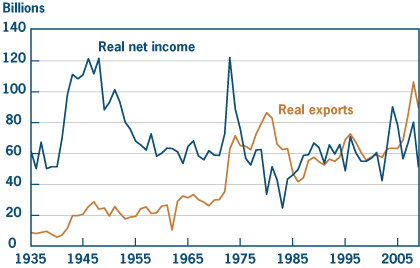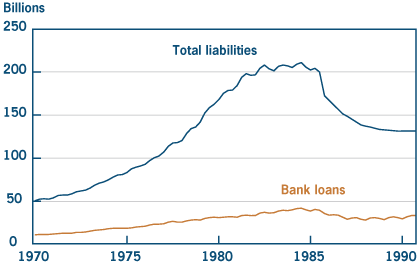- Share
Stripdowns and Bankruptcy Lessons from Agricultural Bankruptcy Reform
One type of financial reform being proposed to deal with the aftermath of the housing crisis is allowing bankruptcy judges the authority to modify residential mortgages in a way referred to as a stripdown. The reform is seen by some as a partial solution to the rise in foreclosures and as a Pandora’s box by others. But the debate is not new one. The 1980s farm foreclosure crisis sparked similar proposals and concerns. Congress decided to enact legislation that contained a stripdown provision, resulting in the creation of Chapter 12 in the bankruptcy code. The effects of Chapter 12 stripdown authority after its enactment shed light on the efficacy of granting bankruptcy judges similar authority for housing loans.
The views authors express in Economic Commentary are theirs and not necessarily those of the Federal Reserve Bank of Cleveland or the Board of Governors of the Federal Reserve System. The series editor is Tasia Hane. This paper and its data are subject to revision; please visit clevelandfed.org for updates.
One type of financial reform being proposed to deal with the aftermath of the housing crisis is allowing bankruptcy judges the authority to modify residential mortgages in a way referred to as a stripdown. The reform is seen by some as a partial solution to the rise in foreclosures and as a Pandora’s box by others. But the debate is not new one. The 1980s farm foreclosure crisis sparked similar proposals and concerns. Congress decided to enact legislation that contained a stripdown provision, resulting in the creation of Chapter 12 in the bankruptcy code. The effects of Chapter 12 stripdown authority after its enactment shed light on the efficacy of granting bankruptcy judges similar authority for housing loans.
The real estate boom and bust of the past decade have produced the biggest housing finance calamity since the Great Depression. Four years after the onset of the foreclosure crisis, mortgage default and foreclosure rates remain near historic levels. Distress in the housing sector has persisted despite a cavalcade of proposals and programs aimed at stemming the tide of foreclosures.
Among these proposals is one to revise Chapter 13 of the bankruptcy code to allow judges to modify mortgages on primary residences. The type of loan modification under consideration is known as a loan cramdown or loan stripdown because the judge would reduce the balance of the secured claim to the current market value of the house, turning the remaining balance of the mortgage into an unsecured claim (which would receive the same proportionate payout as other unsecured debts included in the bankruptcy petition).
Naturally, any proposal that promises to change the rights of creditors or borrowers is likely to engender a lively, sometimes fierce debate. Bankruptcy stripdowns of mortgages secured by primary residences are no exception.
Many proponents of this reform see it as a partial solution to the foreclosure crisis, arguing that it will reduce the number of homes going into foreclosure by increasing the number of sustainable loan modifications. Some advocates do not see it as the magic bullet for the foreclosure crisis, but rather base their case on equity grounds. They point out that just about every other type of secured loan can be stripped down in Chapter 13, including mortgages on rental properties and vacation homes.
Opponents of the reform have advanced several reasons for continuing to prevent stripdowns of primary residences in bankruptcy. One of the most commonly mentioned is the possibility that stripdowns would lead to an increase in mortgage interest rates. They argue that an unintended consequence of mortgage loan modifications under Chapter 13 might be to make homeownership less affordable and, more importantly, less accessible to low- and moderate-income families.
Opponents also fear that making this change to the bankruptcy code during the current financial crisis could prompt an avalanche of Chapter 13 bankruptcy petitions, which could overwhelm the courts.
Finally, many banks and other lenders have expressed concern that allowing bankruptcy stripdowns would shift losses from borrowers to lenders and give bankruptcy judges too much discretion when rewriting the terms of the debt. Any such loss shifting raises issues of fairness with respect to this reform, as it would be changing the rules governing primary residence loans after the terms had been established and agreed upon.
The debate on the impact of bankruptcy stripdowns on the cost and availability of mortgage credit is hampered by a lack of empirical evidence—reflecting in large part the scarcity of available data. The limited empirical evidence on Chapter 13 stripdowns of primary mortgages does not support the concerns of opponents (see for example, a recent study by Adam Levitin and Joshua Goodman). However, as with any single empirical study, one must be cautious about over interpreting their results (see, for example, the response by Mark Scarberry).
This is not the first time policymakers have questioned whether bankruptcy judges should be allowed to do stripdowns of debt secured by a primary residence. In the 1980s, Congress responded to the farm foreclosure crisis with legislation that contained a stripdown provision—and it resulted in the creation of Chapter 12 in the bankruptcy code. Although the farm foreclosure crisis and the current foreclosure crisis differ in many respects, the response to the farm foreclosure crisis is still informative. After all, many of the claims and concerns expressed in the current debate were central in the debate over Chapter 12. The effects of Chapter 12 stripdown authority after its enactment can shed light on the efficacy of allowing bankruptcy judges similar authority under Chapter 13. To that end, this Economic Commentary looks back at the 1980s’ farm lending crisis, the debate surrounding Chapter 12 bankruptcy, and the lessons to be learned for the current debate on Chapter 13 stripdowns.
The Agricultural Lending Crisis
The agricultural lending crisis of the early 1980s had its roots in the agricultural export boom of the 1970s. U.S. agricultural exports rose over 500 percent from 1972 to 1981 (from $8.24 to $43.78 billion), which in turn led to a dramatic rise in commodity prices and farm incomes over the time period. Net farm income peaked at over $27 billion in 1979, a rise of 41 percent over the decade (see figure 1).
Figure 1.

The 1980s farming crisis was a typical boom–bust scenario: Demand for farming goods increased sharply during the early 1970s but saw a corresponding decline in the late 1970s and early 1980s. When prices for their goods were rising, farms expanded and farm real estate prices increased significantly. Iowa, a bellwether state in terms of farm prices in the corn belt, saw the average price of an acre more than quadruple from 1970 to its peak in 1982, only to lose nearly two-thirds of its value over the next five years. Over the same time period, the average price of farmland nationally also rose rapidly, increasing more than 350 percent by 1982, before falling by more than a third by 1987.
The increase in farm land values was accompanied by an increase in agricultural debt loads, as many farmers borrowed to acquire additional acreage (see figure 2). Because they lacked the needed cash and because they expected increased cash flows, many farmers used variable-rate notes to purchase real estate. Farm loan underwriting standards eased, and a speculative lending boom ensued. Lenders began to rely less heavily on the ability of borrowers to service their debt from operating cash flows and more on the continued appreciation of the underlying collateral—the farm land—for repayment. But when demand for farm goods began to fall, farm real estate prices also fell precipitously. As farms’ cash flows decreased and the variable-rate notes used to purchase farm real estate reset, many farmers saw their interest rates increase and found that they could not make payments and were underwater on their mortgages.
Figure 2.

Farmland values peaked in 1981 in the Midwest, where the land-price appreciation had been the greatest, and declined by as much as 49 percent over the next few years before bottoming out in 1987. Farm-sector debt quadrupled from the early 1970s through the mid-1980s. Debt declined by one-third from 1984 through 1987, but much of this reduction reflected the liquidation of farms.
As with homeowners in the recent foreclosure crisis, many farmers—especially those in the Midwest and Southwest, the heart of the farm land bubble–were faced with loans whose face value exceeded the current market value of the real estate serving as collateral for the loan. Many farmers, like many homeowners now, were in danger of losing their primary residences, with little prospect of relief under the bankruptcy options available to farmers at that time. As is the case today, Chapter 13 did not allow for the modification of debt secured by a primary residence. Chapter 11 involved more complexity than a family farm reorganization required, making it difficult to navigate. It also contained provisions that allowed creditors to effectively block a stripdown: undersecured creditors could elect to treat their entire claim as a secured claim, for which they would receive deferred cash payments that totaled the amount of the debt and had a minimum present value equal to the value of the collateral.
Moratoriums on foreclosures in a number of farm states slowed the rising tide of farm foreclosures somewhat, but they provided only a temporary reprieve as the fundamental economic factors of lower land values and lower crop prices relative to the 1970s left many farmers unable to service their existing debt and with almost no possibility of renegotiating their secured loans with creditors.
Unlike the home foreclosure crisis, the overhang of troubled farm debt was highly concentrated, sitting on the books of the Farm Credit Banks, Farmer Mac, and commercial banks in the affected regions. Failures of agricultural banks accelerated in the early to mid-1980s, accounting for a third of all bank failures from 1984 to 1987.
The Coming of Chapter 12 Bankruptcy
Once the farm foreclosure crisis hit, existing provisions in the bankruptcy code proved inadequate for reorganizing small-to-medium sized family farms. While farmers seeking to reorganize could, in principle, choose to file under Chapter 13 (personal bankruptcy) or Chapter 11, the average farmer typically exceeded the debt limits for fi ling under chapter 13. Unfortunately, Chapter 11 was for inappropriate for most of these farmers as well, being a cumbersome and overly complex option, since it is designed to deal with the reorganization of corporations and not small and medium-sized farms.
After much deliberation (some version of the legislation had been under consideration and debate for nearly two-and-a half years) Congress passed the Bankruptcy Judges, United States Trustees, and Family Farmer Bankruptcy Act of 1986. This legislation established a separate chapter in the U.S. Bankruptcy Code, Chapter 12, for farmers defined by the act as family farmers (for the definition, see the summary of Chapter 12 by Phillip L. Kunkel, Jeffrey A. Peterson and Jessica A. Mitchell in the recommended readings). The legislation included a sunset provision allowing the study of the impact of Chapter 12 before it would be made permanent. Chapter 12 was extended twice before becoming permanent in 2005.
What is interesting about the creation of Chapter 12 for the current debate on allowing stripdowns of debt secured by a primary residence is that the Congress responded to the farm foreclosure crisis of the 1980s with legislation that contained a stripdown provision. Stripdowns were permitted for farmers because voluntary modifi cation efforts, even when subsidized by the government, did not lead agricultural lenders to negotiate loan modifications. At the time, opponents of stripdowns made the same arguments people are raising today: Allowing stripdowns would flood bankruptcy courts, permit abuse by borrowers who could afford to pay their loans, and reduce the availability of credit, among other things.
The actual negative impact of the farm stripdown legislation was minor. Although the legislation created a special chapter in the Bankruptcy Code for farmers and allowed stripdowns on primary residences, it did not change the cost and availability of farm credit dramatically. In fact, a United States General Accounting Offi ce (1989) survey of a small group of bankers found that none of them raised interest rates to farmers more than 50 basis points. While this rate change may have been a response to the Chapter 12, it is also consistent with increasing premiums due to the economic environment. This suggests that the changes in the cost and availability of farm credit after the bankruptcy reform differed little from what would be expected in that economic environment, absent reform.
What was most interesting about Chapter 12 is that it worked without working. According to studies by Robert Collender (1993) and Jerome Stam and Bruce Dixon (2004), instead of flooding bankruptcy courts, Chapter 12 drove the parties to make private loan modifications. In fact, although the U.S. General Accounting Office reports that more than 30,000 bankruptcy filings were expected the year Chapter 12 went into effect, only 8,500 were fi led in the first two years. Since then, Chapter 12 bankruptcy filings have continued to fall.
Conclusion
Allowing bankruptcy judges to modify mortgages secured by primary residences remains one of the most contentious proposed responses to the ongoing home mortgage foreclosure crisis. After all, any legislative reform that allows bankruptcy judges to strip down debt secured by primary residences can potentially alter the terms of financial contracts, a change that could have unintended consequences.
The debate is not a new one. The 1980s farm foreclosure crisis sparked similar proposals and concerns. Congress’s response was to include a stripdown provision in a newly created chapter in the bankruptcy code specifically intended for family farms. The effects of that stripdown provision, in place for more than two decades, on the availability and terms of agricultural credit suggest that there has been little if any economically signifi cant impact on the cost and availability of that credit.
In applying the lessons of Chapter 12 reform to the current debate one needs to recognize some important differences between the agricultural foreclosure crisis of the 1980s and the current home foreclosure crisis. First, the structure of the underlying loan markets is different. Unlike mortgages today, few if any of the farm loans in the 1980s were sold or securitized. Moreover, there was more direct government involvement in agricultural loan markets in the 1980s than there was in the mortgage markets leading up to the current housing crisis. Finally, the scale of the current foreclosure crisis is several times larger than the 1980s agricultural crisis, which was limited geographically to the Midwest and Great Plains states. Yet, despite these differences, the response to the farm foreclosure crisis and the impact of bankruptcy reform on agricultural credit markets is still informative for the current debate.
References and Recommended Readings
- “The Effect of Bankruptcy Stripdown on Mortgage Markets,” by Adam J. Levitin and Joshua Goodman. Georgetown University Law Center, Business, Economics, and Regulatory Policy Working Paper Series, research paper, no. 1087816 (February 2008).
- “Bankruptcy: Chapter 12 Reorganization,” by Phillip L. Kunkel, Jeffrey A. Peterson, Jessica A. Mitchell. 2009 (June). University of Minnesota Extension Farm Legal Series.
- “Farm Finance: Participants’ Views Surrounding Chapter 12 Bankruptcy,” U.S. General Accounting Offi ce, 1989 (May). GAO/RCED-89-142BR.
- “An Estimate of the Efficiency Effects of Chapter 12 Bankruptcy,” by Robert N. Collender, 1993. Agricultural Finance Review, vol. 53, no. 65–81.
- “A Critique of Congressional Proposal to Permit Modification of Home Mortgages in Chapter 13 Bankruptcy,” by Mark S. Scarberry, 2010. Pepperdine Law Review, vol. 37, p. 635.
- “Farmer Bankruptcies and Farm Exits in the United States, 1899-2002,” by Jerome M. Stam and Bruce L. Dixon, 2004 (March). Economic Research Service, U.S. Department of Agriculture, Agriculture Information Bulletin, no. 788.
- History of the Eighties. Volume 1: An Examination of the Banking Crises of the 1980s and Early 1990s. Federal Deposit Insurance Corporation. 1997.
- Farm Bankruptcy Amendments: Hearing on The Question of the Remedies Available to Debtors and Creditors under Bankruptcy, How They Relate to the Great Plight of the American Farmer and the Farm Family, statement by Rep. Mike Synar, Oklahoma, before the Subcommittee on Monopolies and Commercial Law, 99th Cong. (1986), 32–33.
- Farm Bankruptcy Amendments: Hearing on H.R. 1397 and H.R. 1399 before the Subcommittee on Monopolies and Commercial Law of the House Committee on the Judiciary, 99th Cong. 31 (1985), statement of James Eatherly, chairman and president of First National Bank of Tonkawa, Oklahoma, and former chairman of the Agricultural Bankers Division of the American Bankers Association.
This work by Federal Reserve Bank of Cleveland is licensed under Creative Commons Attribution-NonCommercial 4.0 International





